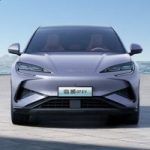 Jim Farley, chief executive of Ford Motor Company, knew it was bad before he boarded his return flight to Michigan. His fact-finding mission to China in May had revealed the cold hard truth.
Jim Farley, chief executive of Ford Motor Company, knew it was bad before he boarded his return flight to Michigan. His fact-finding mission to China in May had revealed the cold hard truth.
That “Chinese EV makers are using a low-cost supply base to undercut the competition on price, offering slick digital features and aggressively expanding to overseas markets.”
According to Farley, “this is an existential threat.”
While U.S., German, and Japanese automakers were busy focusing their electric vehicle (EV) rivalry on Tesla, Chinese EV makers like Xiaomi and BYD were busy upending the market. Lower prices, high-tech interiors and rapid vehicles updates, have brought Chinese made EVs to dominance in the span of a few short years.
Farley’s EV products cost more and do less. The Ford Mustang Mach-E, for example, has a range of 320 miles and a price of $39,995 to $58,995. By comparison, the BYD Sea Lion 07 has a range of 379 miles and a price of $26,700 to $33,200.
American consumers generally have no clue of what has happened. Steep tariffs have kept Chinese EVs out of the U.S. so far. Under the veil of protectionism, the American public is none the wiser.
Some Chinese EV models are available in parts of Europe, South America, and Australia. In Mexico, China-built vehicles – both EVs and combustion-engine vehicles – now account for about 20 percent of sales.
BYD’s cheapest EV, the Seagull, has a starting price of $10,000. It features a rotating touch screen and over 300 miles of driving range. Currently, it’s for sale in China and Latin America. BYD plans to start selling it in Europe next year for around $20,000.
Made in China
In business you can compete on price or quality. Consumers generally must choose between one or the other. They can have cheap, or they can have quality. There can also be an option for best quality for the price, which can be considered good value.
American corporate executives and politicians thought it was wonderful when low skilled manufacturing jobs were offshored to China several decades ago. This boosted bottom lines and masked the money supply inflation that was resulting from Washington’s ballooning deficits. Those lacking critical thinking and imagination even called it a ‘win-win.’
The win for American consumers was they could buy cheaply made light up reindeer antlers and other must have gewgaws produced in China at everyday low prices. The win for American politicians was they could buy votes by spending money taxpayers didn’t have on things taxpayers didn’t need.
Inflation still appeared in the prices of services that couldn’t be offshored. The cost of college tuition and health insurance, for example, went through the roof. However, for many years, the low-cost of consumer goods imported from China kept the CPI from spiraling out of control.
All the while, laborers in the rustbelt lost their manufacturing jobs and got hooked on fentanyl. Similarly, smalltown stores on Main Street USA went out of business as Walmart and Costco moved in to sell Chinese made goods. But no one really cared. Because on balance, trade with China benefitted the coastal elites and the professional services economy.
The apparent public and private advantages of a Made in China world was good for share prices, the economy, and Washington. Or was it?
Better, Faster, Cheaper
In reality, the first half of the China story may not have been as wonderful as advertised. But the second half of the story will be a downright disaster for some of America’s marquee companies.
Things change. Some people advance. Others fall behind. Moreover, things rarely turn out as expected.
Somewhere along the way of this offshoring experiment Chinese businesses stepped up their game. After getting a handle on how to mass produce plastic spatulas and sprinkler heads, industry leaders turned their attention to high-tech.
As American offshoring moved to advanced technologies, China recalibrated its skillset. They also developed the infrastructure and supply chain to support production of high-tech products.
Whereas Chinese engineers didn’t invent any new technology. They learned how to produce it, and make it better, faster, cheaper. With respect to EVs, Chinese automakers found out how they could outcompete their foreign competitors on both price and quality.
“Imitation is the sincerest form of flattery that mediocrity can pay to greatness,” observed Oscar Wilde.
For decades Chinese manufacturers had imitated their American forerunners. Chinese products had a copycat look and feel to them. Many still do. But with the surging dominance of Chinese made EVs, the imitators are becoming the imitated.
Farley is now seeking ways to contract with the same low-cost parts suppliers that Chinese EV makers buy from. He’s focusing on smaller EVs because the weighty batteries needed for big pickup trucks are too costly and rapidly burn through tires.
This was an expensive lesson. The F-150 Lightening pickup wasn’t the great EV score Farley had hoped for. Ford will likely lose about $5 billion on EVs in 2024, which amounts to half of its projected operating profit.
“Executing to a Chinese standard is going to be the most important priority,” Farley said. In other words, in a few years when you buy a Ford EV, what you will really be getting is a more expensive imitation of a BYD EV.
China is Winning the EV War
Elon Musk and Tesla showed the world that an EV is a giant smartphone on wheels. There’s no engine. The drive power is provided by charged batteries. The ingenuity comes from the batteries and the use of regenerative braking to charge the batteries while driving.
By this, the advancement of EVs changed the automaking landscape. Traditional car companies, with decades of experience, didn’t have the same edge in the EV market.
Chinese smartphone companies, like Xiaomi, discovered they had what foreign competitors didn’t. A developed supply chain suited to the low-cost production of the parts and materials needed to manufacture EVs.
Beijing, for its part, saw the opportunity to leapfrog global car companies in the EV market. Massive government subsidies were offered to EV manufacturers and consumers. Similarly, massive investment in car charging stations made EVs viable for everyday users.
At the same time, legacy costs for car companies in America and Europe are limiting their ability to compete. Volkswagen is currently battling with German trade unions who are resisting the company’s proposed factory closures.
“The downturn [for Volkswagen] comes amid a difficult economic environment for the carmaker and an influx of new rivals in Europe, as Volkswagen attempts to survive the transition to electric cars.”
Last fall in America, after a labor strike against the Big Three Detroit automakers, the United Auto Workers locked in big wage raises and increases to retirement contributions and other benefits. The deal may be good for workers. But it will make it near impossible for American car companies to compete with Chinese companies.
In early 2023, Farley and Ford CFO John Lawler took a trip to China and visited Changan Automobile. Following a spin in an EV around Changan’s test track, Lawler remarked, “These guys are way ahead of us.”
Musk recently called the Chinese the “most competitive” carmakers in the world.
Clearly, China is winning the EV war. Should we care?
American consumers have little interest in owning an EV. In fact, only 6.8 percent of new sales in May 2024 were EVs. Perhaps this would change if they could buy a new Made in China EV for just $10,000 a pop.
Of course, Washington protectionism won’t allow it.
[Editor’s note: Have you ever heard of Henry Ford’s dream city of the South? Chances are you haven’t. That’s why I’ve recently published an important special report called, “Utility Payment Wealth – Profit from Henry Ford’s Dream City Business Model.” If discovering how this little-known aspect of American history can make you rich is of interest to you, then I encourage you to pick up a copy. It will cost you less than a penny.]
Sincerely,
MN Gordon
for Economic Prism




